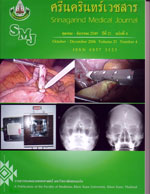Quality of Recovery Score and Pain Control between Continuous Epidural Bupivacaine – Morphine and Intravenous Patient Controlled Analgesia after Upper Abdominal Surgery
Abstract
Background: Good perioperative analgesia especially in upper abdominal surgery may reduce the occurrence of serious postoperative complications. The efficacy and effects of continuous epidural analgesia (CEA) compared with intravenous patient-controlled analgesia (IV PCA) have not been reported in patients undergoing upper abdominal surgery.
Objectives: To compare CEA with IV PCA opioid for postoperative pain control following upper abdominal surgery in cholangiocarcinoma (CHCA) patients in terms of analgesic efficacy, side effects, quality of recovery and duration of hospital stay
Design: Prospective and randomized – controlled trial
Setting: Surgical ward at Srinagarind Hospital, Khon Kaen University
Materials & method: Thirty CHCA patients were randomized allocated to two groups. The patients were received the same general anesthesia plus postoperative continuous epidural morphine (0.05 mg/ml) with 0.0625% bupivacaine in CEA group or postoperative PCA using morphine sulfate (1mg/ml) in PCA group during a period of 24 hrs. Numeric Rating Scale at rest (NRS-R) and on movement (NRS-M) , Likert’s scales, ambulation scores, dosage of morphine consumption and side effects were assessed at 6 and 24 hours postoperatively. The quality of recovery scores (QoR Scores) was performed after 24 hours.
Results: The demographic and surgical data were similar in both groups. The pain scores at 6 and 24 hours between two groups were not statistically significant. The ambulation scores at 24 hours was significantly greater in group CEA compared with group PCA (p=0.046). Intravenous morphine requirement at 24 hrs was significantly less in group CEA (p=0.02). The Likert’s scales, QoR Scores, side effects and duration of hospital stay were comparable for the two groups.
Conclusion: Continuous epidural analgesia( CEA ) was associated with greater ambulation scores and reduced postoperative intravenous morphine requirement compared with morphine base PCA (IV PCA) in CHCA patients undergoing upper abdominal surgery.
Key words: Epidural, analgesia, postoperative pain, upper abdominal surgery




